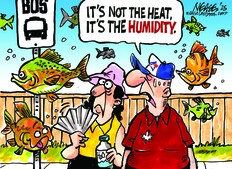CHARLEBOIS: CUSMA-Exempt — the 93% Mirage

Article content
Since Aug. 1, many Canadian commentators have downplayed the impact of the 35% tariffs the United States has imposed on select Canadian goods, citing the Canada–United States–Mexico Agreement (CUSMA) and its oft-repeated claim that 90% to 93% of Canadian exports remain exempt.
While technically true, this statistic masks the much more complicated — and far less reassuring —reality for Canada’s agri-food sector.
A prominent December 2024 study from the University of Sherbrooke concluded that 93% of Canadian exports to the U.S. are tariff-exempt.
On paper, that number may seem comforting. But it tells only part of the story — especially when it comes to food. Tariff exemptions are not automatic. To qualify for duty-free access under CUSMA, Canadian agri-food products must meet strict rules of origin and complex documentation standards. For many small and mid-sized food processors, these bureaucratic hurdles are burdensome and costly. Products with mixed or processed ingredients — such as snack bars, frozen meals, or nut butters —often fall into grey zones that create uncertainty at the border.
The result? Products deemed “exempt” in theory may still be delayed, penalized, or rejected in practice.
Recommended video
Most analyses, including the Sherbrooke study, fail to account for this nuance. As a result, the 93% figure is not only misleading — it’s largely irrelevant for food companies navigating real-world trade.
Worse still, these studies often overlook the geopolitical dynamics shaping food trade. Under President Donald Trump, tariffs have become less about technical qualifications and more about political leverage. The real risk today isn’t simply tariffs themselves — it’s the mere threat of tariffs. Many Canadian food exporters have already lost long-standing American customers spooked by the unpredictability of trade with Canada. Even in the absence of formal tariffs, the perception of risk is enough to drive U.S. buyers toward domestic suppliers. That’s the real game Trump is playing — and winning. Whether a product qualifies for exemption no longer matters if market confidence is eroded.
And make no mistake: for the food industry, where net margins are often razor-thin — typically in the range of 2% to 10% — a 35% tariff is not just inconvenient; it’s existential. It can erase profitability overnight, making entire product lines unviable and undermining long-term investment.
There is no country in the world currently protected by trade agreements in any meaningful way. If you provoke Washington, tariffs — or their threat — will follow. Since Trump’s return, no countries have drawn more retaliatory attention than China and Canada. Both have responded with countermeasures, unlike Japan, South Korea, the U.K., or the European Union — all of which have successfully negotiated more stable trade terms and now face significantly lower tariff exposure than Canada.
Since Mark Carney became Prime Minister in March, Canada has faced more tariffs from the U.S., not fewer. His strategy — if it can be called that — appears to be waiting for the U.S. economy to falter under the weight of its own tariffs. But that’s a dangerous gamble. The American economy, for all its recent job market volatility, remains remarkably resilient. Betting against it has never been a winning strategy — just ask Warren Buffett.
Some Canadians might believe that reduced access to U.S. markets will lead to food surpluses here at home, pushing prices down. That’s a fundamental misunderstanding of how food economics work.
Canadian food exporters rely on scale. Export markets allow companies to spread fixed costs and keep domestic prices affordable. If demand from U.S. buyers dries up, Canadian processors will have no choice but to raise prices domestically to stay afloat.
The result? Higher—not lower—food prices for Canadian consumers.
In short, the 93% tariff exemption statistic may provide political cover or academic reassurance, but it is a mirage. For those of us who work with food companies, study supply chains, and understand export-driven pricing models, the message is clear: Canada’s food economy is far more exposed — and vulnerable — than many realize.
— Dr. Sylvain Charlebois is Director of the Agri-Food Analytics Lab at Dalhousie University, co-host of The Food Professor Podcast and Visiting Scholar at McGill University.











Postmedia is committed to maintaining a lively but civil forum for discussion. Please keep comments relevant and respectful. Comments may take up to an hour to appear on the site. You will receive an email if there is a reply to your comment, an update to a thread you follow or if a user you follow comments. Visit our Community Guidelines for more information.